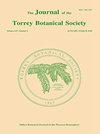Salt spray effects on forest succession in rare coastal sandplain heathlands: evidence from field surveys and Pinus rigida transplant experiments'
IF 0.8
4区 生物学
Q4 PLANT SCIENCES
引用次数: 35
Abstract
GRIFFITHS M. E. AND C. M. ORIANS (Department of Biology, Tufts University, Medford, MA 02155). Salt spray effects on forest succession in rare coastal sandplain heathlands: evidence from field surveys and Pinus rigida transplant experiments. J. Torrey Bot. Soc. 131: 23-31. 2004.-Coastal sandplain heathland is a rare ecosystem maintained by recurrent disturbances and chronic abiotic stress. In areas with low disturbance or stress, heathland communities are succeeded by tree species, such as Pinus rigida, that outcompete native heathland plants. We propose that salt spray is an important natural abiotic stress factor that helps to maintain heathlands near the coast by slowing tree succession. We investigated whether salt spray inhibits succession in heathlands on Martha's Vineyard, Massachusetts, by surveying natural field distributions of species and by quantifying the survival and growth of P rigida seedlings transplanted at different distances from the ocean. Tree species did not grow in areas with high salt spray and multivariate analyses identified salt spray as an important ecological factor influencing species distributions in coastal heathlands. Although transplanted P. rigida seedlings exhibited low mortality close to the ocean, they exhibited higher water stress and needle necrosis as well as inhibition of growth, suggesting that salt spray may be important in suppressing trees close to the盐雾对珍稀滨海沙原石楠地森林演替的影响:来自野外调查和硬松移植试验的证据
GRIFFITHS m.e.和c.m. ORIANS(塔夫茨大学生物系,马萨诸塞州梅德福02155)。盐雾对稀有海岸沙原石楠地森林演替的影响:来自野外调查和硬松移植试验的证据。托里·博特。《社会科学》131:23-31。2004.海岸沙原荒原是一种罕见的生态系统,由周期性干扰和慢性非生物胁迫维持。在干扰或压力较低的地区,石南草原群落被一些树种取代,如刚木松(Pinus rigida),它们比本地石南草原植物更具竞争力。我们认为盐雾是一种重要的自然非生物胁迫因子,通过减缓树木演替来帮助维持海岸附近的荒原。本文通过对麻萨诸塞州玛莎葡萄园石楠荒原物种的野外分布进行调查,并通过对离海洋不同距离移植的石楠幼苗的存活和生长进行量化,研究了盐雾是否会抑制石楠荒原的演替。多因素分析表明,盐雾是影响滨海石南荒原物种分布的重要生态因子。虽然移植后的僵木幼苗在靠近海洋的地方死亡率较低,但它们表现出较高的水分胁迫和针叶坏死以及生长抑制,这表明盐雾在抑制靠近海洋的树木方面可能是重要的
本文章由计算机程序翻译,如有差异,请以英文原文为准。
求助全文
约1分钟内获得全文
求助全文
来源期刊
CiteScore
0.70
自引率
0.00%
发文量
16
审稿时长
>12 weeks
期刊介绍:
The Journal of the Torrey Botanical Society (until 1997 the Bulletin of the Torrey Botanical Club), the oldest botanical journal in the Americas, has as its primary goal the dissemination of scientific knowledge about plants (including thallopyhtes and fungi). It publishes basic research in all areas of plant biology, except horticulture, with an emphasis on research done in, and about plants of, the Western Hemisphere.

 求助内容:
求助内容: 应助结果提醒方式:
应助结果提醒方式:


